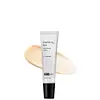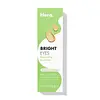What's inside
What's inside
 Key Ingredients
Key Ingredients

 Benefits
Benefits

 Concerns
Concerns

 Ingredients Side-by-side
Ingredients Side-by-side

Water
Skin ConditioningCaprylic/Capric Triglyceride
MaskingNiacinamide
SmoothingPersea Gratissima Oil
Skin ConditioningGlycerin
HumectantCetearyl Alcohol
EmollientPentylene Glycol
Skin ConditioningBellis Perennis Flower Extract
Skin ConditioningCandelilla/Jojoba/Rice Bran Polyglyceryl-3 Esters
EmulsifyingJojoba Oil/Macadamia Seed Oil Esters
Skin ConditioningDiisostearyl Malate
EmollientHydroxyethyl Acrylate/Sodium Acryloyldimethyl Taurate Copolymer
Emulsion StabilisingGlyceryl Stearate
EmollientBehenyl Alcohol
EmollientMoringa Oil/Hydrogenated Moringa Oil Esters
Skin ConditioningHelianthus Annuus Seed Oil
EmollientHieracium Pilosella Extract
MaskingSodium Stearoyl Lactylate
EmulsifyingPhenoxyethanol
PreservativeTetrahexyldecyl Ascorbate
AntioxidantHydroxyacetophenone
AntioxidantMica
Cosmetic ColorantSynthetic Fluorphlogopite
Xanthan Gum
EmulsifyingCaprylyl Glycol
EmollientLycium Barbarum Fruit Extract
AstringentSqualene
Emollient1,2-Hexanediol
Skin ConditioningTitanium Dioxide
Cosmetic ColorantCitric Acid
BufferingSodium Phytate
Phytosteryl Macadamiate
Skin ConditioningSaccharide Isomerate
HumectantIron Oxides
Phytosterols
Skin ConditioningCoelastrella Vacuolata Oil
Skin ConditioningWatanabea Reniformis Oil
Skin ConditioningTocopherol
AntioxidantTin Oxide
AbrasiveWater, Caprylic/Capric Triglyceride, Niacinamide, Persea Gratissima Oil, Glycerin, Cetearyl Alcohol, Pentylene Glycol, Bellis Perennis Flower Extract, Candelilla/Jojoba/Rice Bran Polyglyceryl-3 Esters, Jojoba Oil/Macadamia Seed Oil Esters, Diisostearyl Malate, Hydroxyethyl Acrylate/Sodium Acryloyldimethyl Taurate Copolymer, Glyceryl Stearate, Behenyl Alcohol, Moringa Oil/Hydrogenated Moringa Oil Esters, Helianthus Annuus Seed Oil, Hieracium Pilosella Extract, Sodium Stearoyl Lactylate, Phenoxyethanol, Tetrahexyldecyl Ascorbate, Hydroxyacetophenone, Mica, Synthetic Fluorphlogopite, Xanthan Gum, Caprylyl Glycol, Lycium Barbarum Fruit Extract, Squalene, 1,2-Hexanediol, Titanium Dioxide, Citric Acid, Sodium Phytate, Phytosteryl Macadamiate, Saccharide Isomerate, Iron Oxides, Phytosterols, Coelastrella Vacuolata Oil, Watanabea Reniformis Oil, Tocopherol, Tin Oxide
Water
Skin ConditioningC13-15 Alkane
SolventPropanediol
SolventDiisostearyl Malate
EmollientCaprylic/Capric Triglyceride
MaskingSynthetic Fluorphlogopite
Glycerin
Humectant1,2-Hexanediol
Skin ConditioningCaffeine
Skin ConditioningCetearyl Alcohol
EmollientHelianthus Annuus Seed Oil Unsaponifiables
EmollientCoffea Arabica Seed Extract
MaskingAllantoin
Skin ConditioningTocopherol
AntioxidantNiacinamide
SmoothingHydrogenated Rapeseed Oil
EmollientFucus Vesiculosus Extract
EmollientPolymethyl Methacrylate
Cetearyl Glucoside
EmulsifyingVaccinium Macrocarpon Seed Oil
Skin ConditioningOctyldodecanol
EmollientHydroxyethyl Acrylate/Sodium Acryloyldimethyl Taurate Copolymer
Emulsion StabilisingPanax Quinquefolius Root Extract
AstringentHaematococcus Pluvialis Extract
AntioxidantAcrylates/C10-30 Alkyl Acrylate Crosspolymer
Emulsion StabilisingLecithin
EmollientBehenyl Alcohol
EmollientArachidyl Glucoside
EmulsifyingXanthan Gum
EmulsifyingPotassium Hydroxide
BufferingSodium Dilauramidoglutamide Lysine
HumectantArachidyl Alcohol
EmollientSodium Phytate
Hexylene Glycol
EmulsifyingSorbitan Isostearate
EmulsifyingMalic Acid
BufferingCaprylyl Glycol
EmollientTin Oxide
AbrasiveGlucose
HumectantAstaxanthin
Skin ConditioningMica
Cosmetic ColorantCI 77891
Cosmetic ColorantCI 77492
Cosmetic ColorantWater, C13-15 Alkane, Propanediol, Diisostearyl Malate, Caprylic/Capric Triglyceride, Synthetic Fluorphlogopite, Glycerin, 1,2-Hexanediol, Caffeine, Cetearyl Alcohol, Helianthus Annuus Seed Oil Unsaponifiables, Coffea Arabica Seed Extract, Allantoin, Tocopherol, Niacinamide, Hydrogenated Rapeseed Oil, Fucus Vesiculosus Extract, Polymethyl Methacrylate, Cetearyl Glucoside, Vaccinium Macrocarpon Seed Oil, Octyldodecanol, Hydroxyethyl Acrylate/Sodium Acryloyldimethyl Taurate Copolymer, Panax Quinquefolius Root Extract, Haematococcus Pluvialis Extract, Acrylates/C10-30 Alkyl Acrylate Crosspolymer, Lecithin, Behenyl Alcohol, Arachidyl Glucoside, Xanthan Gum, Potassium Hydroxide, Sodium Dilauramidoglutamide Lysine, Arachidyl Alcohol, Sodium Phytate, Hexylene Glycol, Sorbitan Isostearate, Malic Acid, Caprylyl Glycol, Tin Oxide, Glucose, Astaxanthin, Mica, CI 77891, CI 77492
Ingredients Explained
These ingredients are found in both products.
Ingredients higher up in an ingredient list are typically present in a larger amount.
1,2-Hexanediol is a synthetic liquid and another multi-functional powerhouse.
It is a:
- Humectant, drawing moisture into the skin
- Emollient, helping to soften skin
- Solvent, dispersing and stabilizing formulas
- Preservative booster, enhancing the antimicrobial activity of other preservatives
Behenyl Alcohol is a type of fatty alcohol (these are different from the drying, solvent alcohols).
Fatty Alcohols have hydrating properties and are most often used as an emollient or to thicken a product. They are usually derived from natural fats and oils; behenyl alcohol is derived from the fats of vegetable oils.
Emollients help keep your skin soft and hydrated by creating a film that traps moisture in.
In 2000, Behenyl Alcohol was approved by the US as medicine to reduce the duration of cold sores.
Learn more about Behenyl AlcoholThis ingredient is an emollient, solvent, and texture enhancer. It is considered a skin-softener by helping the skin prevent moisture loss.
It helps thicken a product's formula and makes it easier to spread by dissolving clumping compounds.
Caprylic Triglyceride is made by combining glycerin with coconut oil, forming a clear liquid.
While there is an assumption Caprylic Triglyceride can clog pores due to it being derived from coconut oil, there is no research supporting this.
Learn more about Caprylic/Capric TriglycerideCaprylyl Glycol is a humectant and emollient, meaning it attracts and preserves moisture.
It is a common ingredient in many products, especially those designed to hydrate skin. The primary benefits are retaining moisture, skin softening, and promoting a healthy skin barrier.
Though Caprylyl Glycol is an alcohol derived from fatty acids, it is not the kind that can dry out skin.
This ingredient is also used as a preservative to extend the life of products. It has slight antimicrobial properties.
Learn more about Caprylyl GlycolCetearyl alcohol is a mixture of two fatty alcohols: cetyl alcohol and stearyl alcohol. It is mainly used as an emulsifier. Emulsifiers help prevent the separation of oils and products. Due to its composition, it can also be used to thicken a product or help create foam.
Cetearyl alcohol is an emollient. Emollients help soothe and hydrate the skin by trapping moisture.
Studies show Cetearyl alcohol is non-toxic and non-irritating. The FDA allows products labeled "alcohol-free" to have fatty alcohols.
This ingredient is usually derived from plant oils such as palm, vegetable, or coconut oils. There is debate on whether this ingredient will cause acne.
Due to the fatty acid base, this ingredient may not be Malassezia folliculitis safe.
Learn more about Cetearyl AlcoholDiisostearyl Malate is an emollient and most often used in lip products. It comes from isostearyl alcohol, a fatty acid, and malic acid, an AHA.
As an emollient, Diisostearyl Malate helps create a thin film on your skin to trap moisture in. This helps keep your skin soft and smooth.
Glycerin is already naturally found in your skin. It helps moisturize and protect your skin.
A study from 2016 found glycerin to be more effective as a humectant than AHAs and hyaluronic acid.
As a humectant, it helps the skin stay hydrated by pulling moisture to your skin. The low molecular weight of glycerin allows it to pull moisture into the deeper layers of your skin.
Hydrated skin improves your skin barrier; Your skin barrier helps protect against irritants and bacteria.
Glycerin has also been found to have antimicrobial and antiviral properties. Due to these properties, glycerin is often used in wound and burn treatments.
In cosmetics, glycerin is usually derived from plants such as soybean or palm. However, it can also be sourced from animals, such as tallow or animal fat.
This ingredient is organic, colorless, odorless, and non-toxic.
Glycerin is the name for this ingredient in American English. British English uses Glycerol/Glycerine.
Learn more about GlycerinThis is a synthetic polymer. It helps improve the texture of products by adding thickness and gel-like feel.
It is also an emulsifer, meaning it prevents ingredients such as oil and water from separating. It also helps evenly disperse other ingredients.
Mica is a naturally occurring mineral used to add shimmer and color in cosmetics. It can also help improve the texture of a product or give it an opaque, white/silver color.
Serecite is the name for very fine but ragged grains of mica.
This ingredient is often coated with metal oxides like titanium dioxide. Trace amounts of heavy metals may be found in mica, but these metals are not harmful in our personal products.
Mica has been used since prehistoric times throughout the world. Ancient Egyptian, Indian, Greek, Roman, Aztec, and Chinese civilizations have used mica.
Learn more about MicaNiacinamide is a multitasking form of vitamin B3 that strengthens the skin barrier, reduces pores and dark spots, regulates oil, and improves signs of aging.
And the best part? It's gentle and well-tolerated by most skin types, including sensitive and reactive skin.
You might have heard of "niacin flush", or the reddening of skin that causes itchiness. Niacinamide has not been found to cause this.
In very rare cases, some individuals may not be able to tolerate niacinamide at all or experience an allergic reaction to it.
If you are experiencing flaking, irritation, and dryness with this ingredient, be sure to double check all your products as this ingredient can be found in all categories of skincare.
When incorporating niacinamide into your routine, look out for concentration amounts. Typically, 5% niacinamide provides benefits such as fading dark spots. However, if you have sensitive skin, it is better to begin with a smaller concentration.
When you apply niacinamide to your skin, your body converts it into nicotinamide adenine dinucleotide (NAD). NAD is an essential coenzyme that is already found in your cells as "fuel" and powers countless biological processes.
In your skin, NAD helps repair cell damage, produce new healthy cells, support collagen production, strengthen the skin barrier, and fight environmental stressors (like UV and pollution).
Our natural NAD levels start to decline with age, leading to slower skin repair, visible aging, and a weaker skin barrier. By providing your skin niacinamide, you're recharging your skin's NAD levels. This leads to stronger, healthier, and younger looking skin.
Another name for vitamin B3 is nicotinamide. This vitamin is water-soluble and our bodies don't store it. We obtain Vitamin B3 from either food or skincare. Meat, fish, wheat, yeast, and leafy greens contain vitamin B3.
The type of niacinamide used in skincare is synthetically created.
Learn more about NiacinamideSodium Phytate is the synthetic salt form of phytic acid. Phytic acid is an antioxidant and can be found in plant seeds.
Sodium Phytate is a chelating agent. Chelating agents help prevent metals from binding to water. This helps stabilize the ingredients and the product.
Synthetic Fluorphlogopite is the synthethic version of mica. It consists of fluorine, aluminum and silicate.
Synthetic Fluorphlogopite is used to add volume to products.
It is considered non-irritating on the skin.
Learn more about Synthetic FluorphlogopiteTin Oxide is an inorganic oxide used to add opacity and volume to a product. In nature, it is already found in mineral form. The main ore of tin is an opaque and shiny mineral called casseterite.
Tin Oxide helps remove translucency in a product, or make it more opaque. Besides adding opacity, tin oxide is used for bulking to add volume.
Tocopherol (also known as Vitamin E) is a common antioxidant used to help protect the skin from free-radicals and strengthen the skin barrier. It's also fat soluble - this means our skin is great at absorbing it.
Vitamin E also helps keep your natural skin lipids healthy. Your lipid skin barrier naturally consists of lipids, ceramides, and fatty acids. Vitamin E offers extra protection for your skin’s lipid barrier, keeping your skin healthy and nourished.
Another benefit is a bit of UV protection. Vitamin E helps reduce the damage caused by UVB rays. (It should not replace your sunscreen). Combining it with Vitamin C can decrease sunburned cells and hyperpigmentation after UV exposure.
You might have noticed Vitamin E + C often paired together. This is because it is great at stabilizing Vitamin C. Using the two together helps increase the effectiveness of both ingredients.
There are often claims that Vitamin E can reduce/prevent scarring, but these claims haven't been confirmed by scientific research.
Learn more about TocopherolWater. It's the most common cosmetic ingredient of all. You'll usually see it at the top of ingredient lists, meaning that it makes up the largest part of the product.
So why is it so popular? Water most often acts as a solvent - this means that it helps dissolve other ingredients into the formulation.
You'll also recognize water as that liquid we all need to stay alive. If you see this, drink a glass of water. Stay hydrated!
Learn more about WaterXanthan gum is used as a stabilizer and thickener within cosmetic products. It helps give products a sticky, thick feeling - preventing them from being too runny.
On the technical side of things, xanthan gum is a polysaccharide - a combination consisting of multiple sugar molecules bonded together.
Xanthan gum is a pretty common and great ingredient. It is a natural, non-toxic, non-irritating ingredient that is also commonly used in food products.
Learn more about Xanthan Gum